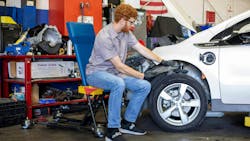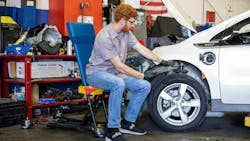This is Part Two of a two-part story. Click here to see Part One.
Shop safety managers are already aware of the common pieces of equipment that have been around for decades: fire extinguishers, first aid kits, safety glasses, gloves, and other PPE are a given, and these fundamentals remain essential to protecting the well-being of team members. However, with everything going on in a shop environment, the list of safety products and equipment that should be commonplace in the bay is ever-growing.
“As we think of the future, we see a new, younger, and probably smaller workforce in automotive and fleet service. This smaller workforce won’t have the time for lengthy apprenticeships or on-the-job training,” said Pete Liebetreu, VP of marketing and HD product manager for Hunter Engineering. “That drives the need for simpler, faster, more automatic equipment.”
Embracing innovation and incorporating new tools designed to enhance workplace safety makes adapting to changing demands and better safeguarding techs even easier. That being said, it’s important to remain cognizant of issues and injuries that can fly under the radar, and even more important to seek out unique solutions designed to prevent them.
For example, with falls, back injuries, and the like being immediate tickets to some unwanted time off, it can be easy for shop managers and technicians to overlook more subtle ailments, like the overall wear and tear on the body that can set in gradually over years of poor posture, repetitive movements, etc.
Sean Price, director of sales operations for BendPak, explained how this is becoming an even bigger issue, as “one of the biggest challenges in the industry continues to be the aging of the workforce and the ongoing technician shortage.” Older technicians may be more susceptible to injuries and strains, particularly when performing physically demanding tasks, and protecting technicians is even more of a priority as their value as assets continues to increase.
He noted that improving ergonomics is going to be essential when it comes to keeping techs productive on the job longer. He highlighted BendPak’s Ergochair, a product released in 2022, as a solution dedicated to helping technicians work more comfortably. “Ergochair’s product line includes a family of crossover work seats that make performing awkward tasks in the shop more ergonomic, reducing stress and strain on the body to deliver greater productivity with fewer injuries,” Price said.
Steve Perlstein, president of Mohawk Lifts, discussed head injuries as another safety issue not widely acknowledged in the commercial vehicle shop. It’s important to have lifts at the proper ergonomic height for repair efficiency and technician comfort while working, but that also leaves them at a perfect height to smack their head when navigating a repair if they’re not careful.
Perlstein recommended Mohawk’s safety head guards as an inexpensive solution that can be installed on a two-post lift in seconds. The head guards are simple foam caps designed for easy peel-and-stick application and fit all Mohawk swing arm sliders, preventing technicians from hurting or cutting their heads on the hard, steel arms.
This is just one of numerous recent solutions that make two-post lifts safer, as Price went into detail on some of BendPak’s newer offerings. He mentioned their Automatic Swing Arm Restraint System, which keeps the lift’s four swing arms in place under the vehicle to prevent the vehicle from shifting or sliding off.
“Swing arm restraints themselves aren’t new, but traditional systems have had a difficult time withstanding the excess forces applied to them when lifted vehicles suddenly and unexpectedly shift, usually due to improper loading or the removal/addition of heavy components. This can cause the vehicle to fall,” he said. “[Our design] uses 360 degrees of forged steel teeth to secure the arms in place and withstand an industry-leading 2,000 lbs. of side force, so technicians can work without worry.”
Even though shop equipment continues to become safer as manufacturers look for unique ways to protect techs, as LockNClimb’s Lary pointed out, sometimes adoption takes time.
“Many mechanics have decades of experience using older methods, and it is sometimes a challenge getting them to change from processes that work to processes that work better,” he said. “But once they see their colleagues using them and experience the ladders themselves, they embrace the modern features of safety and workability.”
Protecting the bottom line
As is the case with most other aspects of the CV industry, shop safety equipment is constantly evolving and becoming more efficient. Managers must stay up to date on the most effective products for their shop.
“As a lift manufacturer, technicians are trusting us with their lives every day,” Price noted. “We take that responsibility extremely seriously and are constantly evaluating how our products can help improve productivity and safety on the job.”
While optimizing processes and saving time should be a focus of any shop’s operation, cutting corners where safety is concerned never pays off. Ignoring safety ruins productivity, and having employees out of commission makes a manager’s job harder. By extension, quality safety equipment means more uptime.
“If it’s fast and easy to use, then shortcuts aren’t needed,” Liebetreu said. “If it’s simple to use, then misunderstandings are avoided.”
On the bright side, however, Lary noted that they “find that safety managers are becoming more aware of problems that cause costly repeat accidents and look for ways to prevent them. This is when we get a call, and it is usually urgent. We take great pride in being able to provide solutions to these problems.”
About the Author

Lucas Roberto
Lucas Roberto is an Associate Editor for Fleet Maintenance magazine. He has written and produced multimedia content over the past few years and is a newcomer to the commercial vehicle industry. He holds a bachelor's in media production and a master's in communication from High Point University in North Carolina.


